To install carpet runners on stairs, measure and cut the runners to fit each step, apply adhesive tape, and secure the runners to the stairs. Installing carpet runners on stairs involves measuring and cutting the runners to size, applying adhesive tape, and securely attaching them to each step.
This process not only enhances the aesthetic appeal of the stairs but also provides added safety by reducing slipping and noise. In this guide, we will walk you through the step-by-step process of installing carpet runners on stairs, ensuring a seamless and professional finish.
Whether you are a seasoned DIY enthusiast or a beginner, this tutorial will equip you with the knowledge and skills needed to successfully complete the installation. So let’s dive in and transform your staircase with a stylish and functional carpet runner.
Understanding The Different Types Of Carpet Runners
When it comes to enhancing the aesthetic appeal and durability of your stairs, carpet runners are a must-have. But before you start installing them, it’s important to understand the different types of carpet runners available in the market. Knowing the various options will help you make an informed decision that suits your staircase and personal style. In this section, we will explore the importance of carpet runners for stairs, the different materials used, and factors to consider when choosing the right width and length.

Why are carpet runners important for stairs?
Carpet runners serve not only as an attractive addition to your stairs but also offer a plethora of benefits. Let’s take a look at why these runners are essential:
- Enhanced safety: Stairs can be slippery, especially when bare. Carpet runners provide added traction and reduce the chances of accidents, making your staircase safer for everyone.
- Reduced noise: Walking up and down the stairs can create noise that echoes throughout the house. The soft texture of carpet runners helps absorb the sound, creating a quieter and more peaceful environment.
- Protection for your stairs: Stairs often endure a lot of wear and tear. By installing carpet runners, you can protect your stairs from scratches, scuffs, and other damages, ensuring their longevity.
- Aesthetics and style: Carpet runners come in a variety of colors, patterns, and textures, allowing you to add a touch of personal style to your staircase. They can also complement the overall decor of your home, making your stairs visually appealing.
Different materials used for carpet runners
Carpet runners are available in various materials, each with its unique characteristics and benefits. Here are some popular options:
| Material | Description |
|---|---|
| Wool | Known for its durability and natural insulation properties, wool is a popular choice for carpet runners. It offers a luxurious feel and comes in a wide range of colors and patterns. |
| Nylon | Nylon is a synthetic material that is highly resistant to stains and fading. It is a cost-effective option and known for its resilience and durability. Nylon carpet runners are available in a variety of styles and colors. |
| Sisal | Sisal is a natural plant fiber that provides a unique and organic look to your staircase. It is highly durable and resistant to stains, making it ideal for high-traffic areas. Sisal carpet runners are available in various earthy tones. |
When choosing the material for your carpet runner, consider factors such as durability, maintenance requirements, and overall aesthetic appeal.
Considering the width and length of the runners:
Once you’ve decided on the type of carpet runner you want, it’s crucial to determine the right width and length. Here are some considerations to guide you:
- Width: The width of the carpet runner should match the width of your stairs, leaving a small border on either side. This ensures a snug fit and prevents any tripping hazards.
- Length: Measure the length of each individual step and add them together to determine the total length needed for the runner. It should cover the entire length of the staircase while leaving a few inches of space at the top and bottom for a clean and finished look.
By understanding the different types of carpet runners, and their importance, and considering the width and length, you can confidently proceed with installing the perfect carpet runner for your stairs. So let’s dive into the installation process!
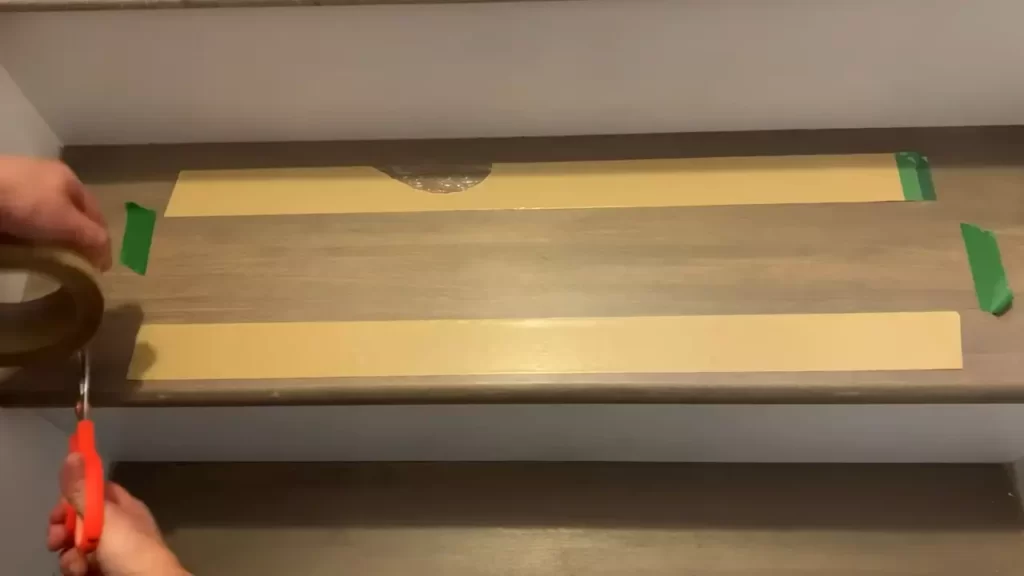
Removing Existing Carpet Or Flooring On The Stairs
Before you can install carpet runners on your stairs, you’ll need to remove any existing carpet or flooring. This step is crucial for ensuring a smooth and clean surface to work with. In this section, we will guide you through the process of removing carpet or flooring on the stairs.
Tools needed for removing carpet or flooring
Before you start the removal process, make sure you have the following tools handy:
| Tools |
|---|
| Utility knife |
| Pliers |
| Flathead screwdriver |
| Hammer |
| Pry bar |
Step-by-step process to remove carpet or flooring
- Start by removing any obstacles or furniture from the stairs to ensure a clear and safe workspace.
- Use a utility knife to cut the carpet or flooring into manageable sections. This will make it easier to remove.
- With the pliers, grip the edge of the carpet or flooring and pull it away from the stairs. Make sure to exert steady and even pressure to avoid tearing.
- If there are any nails or staples holding the carpet or flooring in place, use a flathead screwdriver or pliers to remove them.
- For stubborn edges or corners, use a pry bar and gently lift the carpet or flooring until it comes loose.
- Continue this process until all the carpet or flooring has been removed from the stairs.
- Inspect the stairs for any remaining adhesive or residue. If needed, use a scraper or solvent to remove it.
Precautions to take during the removal process
While removing carpet or flooring, it’s important to take certain precautions to ensure safety and a successful removal. Here are some precautions to keep in mind:
- Wear gloves to protect your hands from any sharp objects or potential hazards.
- Be mindful of any exposed tack strips or nails to avoid injury.
- Take breaks and avoid overexertion to prevent strain or fatigue.
- Work in a well-ventilated area or use a mask if there is dust or strong odors from adhesives or solvents.
- Keep pets and children away from the work area for their safety.
By following these steps and taking the necessary precautions, you’ll be able to effectively remove the existing carpet or flooring on your stairs, creating a clean canvas for installing your desired carpet runners.
Preparing The Stairs For Installation
Installing carpet runners on stairs not only provides extra grip and safety but also adds a touch of elegance to your home. Before you begin the installation process, it’s crucial to prepare the stairs properly. This involves assessing the condition of the stairs, repairing any damages or imperfections, and cleaning the stairs thoroughly. Follow these steps to ensure a seamless and long-lasting installation.
Assessing the condition of the stairs
Firstly, take a close look at the stairs to evaluate their overall condition. Check for any loose or squeaky steps, cracks, or uneven surfaces. Identifying these issues beforehand will help you address them properly and ensure a smooth installation process. Remember, a solid foundation is the key to a durable and aesthetically pleasing carpet runner.
Repairing any damages or imperfections
If you come across any damages or imperfections during your assessment, it’s essential to repair them before proceeding any further. Repairing cracks or uneven surfaces will not only prevent further damage but also provide a stable surface for the carpet runner installation. Use suitable wood fillers or adhesives to fix any loose or squeaky steps, ensuring that they are secure and stable.
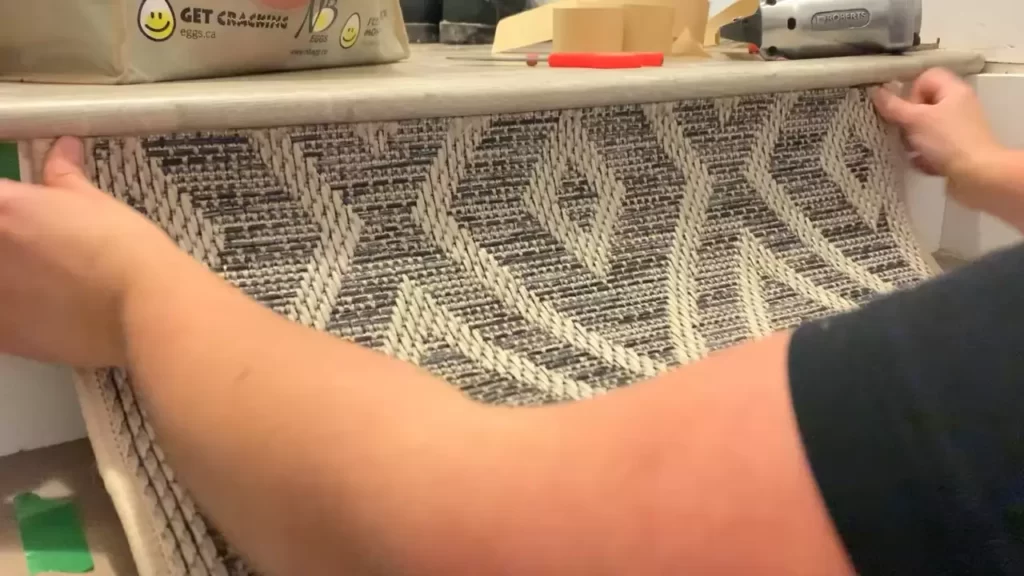
Cleaning the stairs thoroughly
Before installing the carpet runner, it’s crucial to clean the stairs thoroughly. Remove any dirt, dust, or debris that may have accumulated over time. Start by sweeping the stairs with a broom, paying extra attention to the corners and edges. Next, use a vacuum cleaner or a handheld attachment to remove any remaining dirt or particles that may have settled on the surface.
Once you have removed all visible dirt and debris, it’s time to deep clean the stairs. Fill a bucket with warm water and add a mild detergent or carpet cleaning solution. Dip a clean cloth or sponge into the soapy water and wring it out until it’s damp. Gently scrub the stairs, focusing on high-traffic areas and any stains or spots. Rinse the cloth or sponge frequently and change the water if necessary. Once the stairs are cleaned, use a clean, dry cloth or towel to pat them dry. Allow the stairs to air dry completely before moving on to the installation phase.
| Steps to Clean the Stairs |
|---|
| Step 1: Sweep the stairs with a broom |
| Step 2: Vacuum the stairs to remove remaining dirt or particles |
| Step 3: Fill a bucket with warm water and add a mild detergent or carpet cleaning solution |
| Step 4: Dip a clean cloth or sponge into the soapy water and wring it out until it’s damp |
| Step 5: Gently scrub the stairs, focusing on high-traffic areas and any stains or spots |
| Step 6: Rinse the cloth or sponge frequently and change the water if necessary |
| Step 7: Use a clean, dry cloth or towel to pat the stairs dry |
| Step 8: Allow the stairs to air dry completely |
By thoroughly assessing the condition, repairing any damages, and cleaning the stairs, you are setting a solid foundation for the installation of your carpet runner. This preparation stage is crucial for achieving a professional and long-lasting result that will enhance both the beauty and functionality of your staircase.
Taking Accurate Measurements Of The Stairs
Installing carpet runners on stairs can instantly elevate the look of your home, adding both style and functionality. However, it’s crucial to take accurate measurements before beginning the installation process. This ensures that you have the right amount of carpet runner and that it fits perfectly on your stairs. In this section, we’ll guide you through the process of taking accurate measurements for your staircase, step by step. Let’s get started!
Tools required for measuring
Before you begin measuring your stairs, make sure you have the following tools:
- Tape measure: This essential tool will help you accurately measure the width, length, and other dimensions of your stairs.
- Pencil or marker: Use this to mark your measurements on the stairs or a separate piece of paper.
- Notepad or paper: You’ll need this to jot down your measurements, ensuring you don’t forget any crucial details.
Measuring the width and length of the stairs
When measuring the width and length of the stairs, follow these steps:
- Start by measuring the width of a single step. Place your tape measure at one end of the step and extend it to the opposite end. Make sure to measure the width at the widest point, excluding the nosing or overhang if present.
- Repeat this process for all the steps, recording each width measurement as you go.
- Next, measure the length of a single step. Start from the back of the step, where it meets the riser, and extend your tape measure to the front. Ensure that you measure the entire length, including any overhang
- Continue measuring the length of each step, marking down the measurements as you progress.
Accounting for tread and riser dimensions
When installing carpet runners, it’s important to consider the dimensions of the tread and riser. This will help you determine the amount of carpet runner needed and ensure a proper fit. Here’s how to account for tread and riser dimensions:
- Measure the depth of the tread by placing your tape measure from the nosing (front edge of the step) to the back where it meets the riser.
- Note down the measurement for each step.
- Next, measure the height of the riser by placing your tape measure from the bottom of the previous step’s tread to the top of the current step’s tread.
- Record the height measurement for each step.
By taking accurate measurements of the width, length, tread depth, and riser height, you’ll ensure that your carpet runner fits snugly and looks aesthetically pleasing on your stairs. Now that you have your measurements, you’re ready to move on to the next step of installing the carpet runners on your stairs.
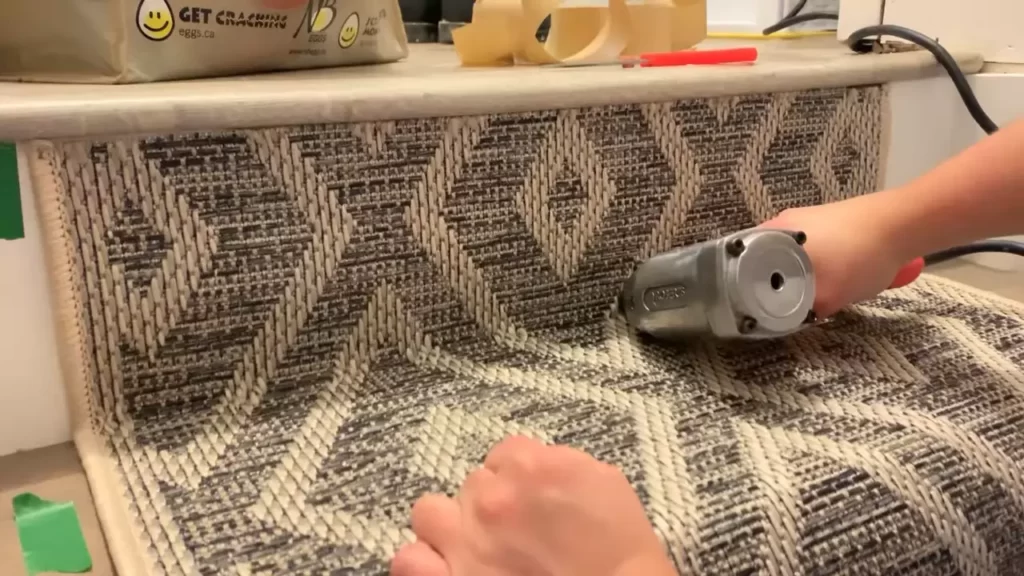
Cutting The Carpet Runners
When it comes to installing carpet runners on stairs, cutting the carpet runners to the appropriate length is a crucial step. This ensures that the runners fit perfectly on each step, providing both aesthetic appeal and functional stability. In this section, we will discuss the importance of choosing the right cutting tools, offer tips for precise cutting, and provide insights on ensuring straight and clean edges of the carpet runners.
Choosing the Right Cutting Tools
To achieve accurate and clean cuts, it is essential to have the appropriate cutting tools. Here are a few options to consider:
| Cutting Tool | Usage |
|---|---|
| Carpet Knife | A versatile tool for cutting carpet runners. Its sharp, retractable blade allows for precise cuts. |
| Utility Knife | Similar to a carpet knife, a utility knife can also be used for cutting carpet runners. Ensure that the blade is sharp for clean cuts. |
| Straight Edge | A long, sturdy ruler or a specialized tool designed specifically for cutting straight lines. It helps ensure accuracy and prevents the blade from veering off course. |
Tips for Precise Cutting
- Before cutting, make sure you measure each step carefully to determine the exact length of the carpet runner needed. It’s always better to double-check your measurements to avoid any mistakes.
- Use a straight edge as a guide to ensure a straight cut. Place the straight edge against the carpet, aligning it with the marked cutting line. With a steady hand, carefully cut along the edge of the straight edge.
- For cleaner cuts, consider changing the blade of your cutting tool regularly. A dull blade can result in frayed edges or uneven cuts.
- Take your time when cutting to maintain control over the cutting tool. Rushing the process can lead to mistakes and imprecise cuts.
Ensuring Straight and Clean Edges
To achieve straight and clean edges, follow these guidelines:
- Make small, gentle strokes when cutting. Applying too much pressure or forcing the blade can cause the carpet fibers to fray or tear.
- When cutting around corners or along curves, carefully navigate the cutting tool to maintain a smooth and even edge. Take your time and follow the contour of the steps.
- After cutting the carpet runner, use a straight edge or ruler to check the straightness of the cut edge. Make any necessary adjustments before proceeding with installation.
By choosing the right cutting tools, employing precise cutting techniques, and ensuring straight and clean edges, you can successfully cut the carpet runners for your stairs. This step sets the foundation for a professionally installed carpet runner that enhances the beauty and safety of your staircase.
Applying Double-Sided Carpet Tape
When it comes to installing carpet runners on stairs, using double-sided carpet tape is a crucial step in ensuring a secure and long-lasting application. Carpet tape is a strong adhesive that can provide the necessary grip and stability to keep the carpet runner in place, even in high-traffic areas. In this section, we will discuss the steps for applying double-sided carpet tape properly.
Selecting High-Quality Carpet Tape
The first step in applying double-sided carpet tape is to select a high-quality tape that is specifically designed for use with carpets. Look for a tape that is strong, durable, and specifically formulated to adhere to both the carpet and the stairs. It is also essential to choose a tape that is wide enough to provide ample surface coverage for a secure bond.
Properly Positioning the Tape on the Stairs
Once you have selected the right carpet tape, the next step is to properly position it on the stairs. Start by cleaning the stairs thoroughly to remove any dirt, dust, or debris that may hinder adhesion. Next, measure the width of the carpet runner and mark the center of each step with a pencil or tape. This will serve as your reference point for aligning the tape.
Starting at the bottom step, carefully peel off the backing from the carpet tape, ensuring not touch the adhesive side. Align the tape with the marked center of the step and press it firmly onto the surface, working your way up the stairs. Make sure to smooth out any wrinkles or bubbles as you go to ensure a flat and secure surface for the carpet runner.
Ensuring Secure Adhesion
Once the double-sided carpet tape has been applied to all the steps, it is crucial to ensure secure adhesion. Use a hand roller or a firm object to press the carpet tape onto the stairs firmly. This will help activate the adhesive and create a stronger bond between the tape and the stairs. Additionally, walk up and down the stairs a few times to test the adhesion, making adjustments if necessary.
By following these steps and using high-quality carpet tape, you can ensure that your carpet runner remains securely in place on the stairs for years to come. Properly applied double-sided carpet tape will provide the necessary grip and stability to withstand everyday wear and tear, giving you peace of mind and a well-protected staircase.
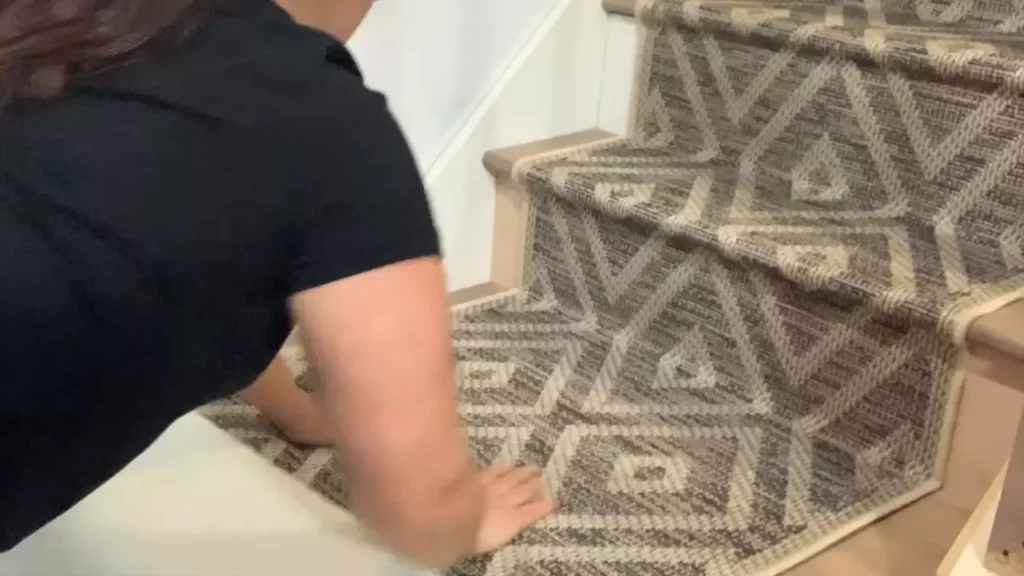
Securing The Carpet Runners
Securing the carpet runners is a crucial step in the installation process to ensure that they stay in place and provide a safe and visually appealing stairway. By following these steps, you can ensure that your carpet runners are securely fastened and will withstand daily wear and tear.
Placing the carpet runners on the stairs
To start securing your carpet runners, you need to properly place them on the stairs. Begin by unrolling the carpet runners and positioning them at the top of the stairs. Make sure the runners are centered and overlap the stair edges slightly for a neat and professional look.
Aligning the runners properly
Once the carpet runners are placed, take the time to align them properly. This step is essential for a polished and symmetrical finished look. Start by ensuring that the runners are straight and parallel to the edge of the stairs. Use a measuring tape or a straight edge to double-check the alignment before proceeding to the next step.
Attaching the runners using staples or nails
After aligning the carpet runners, it’s time to attach them securely to the stairs. One common method is using staples or nails. However, be sure to check your local building codes or regulations to ensure this method is allowed in your area.
When using staples or nails, follow these steps:
- Start from the top of the stairs and work your way down.
- Position the runner against the stair riser, leaving a small gap between the edge of the runner and the stair edge.
- Using a staple gun or a hammer and nails, secure the runner to the stair tread, ensuring that it is tightly held in place.
- Continue to staple or nail the runner along the length of the stairs, spacing the fasteners approximately every 5-6 inches or as needed, depending on the runner material and thickness.
- Ensure that each staple or nail is firmly secured, preventing the runner from coming loose.
By following these steps, you can securely attach your carpet runners with staples or nails, allowing for a durable and long-lasting installation.
Remember, there are alternative methods for securing carpet runners, such as adhesive tapes or double-sided carpet tape. These methods may be more suitable depending on the type of runner and the condition of your stairs. Consider consulting with a professional or researching alternative installation techniques if needed.
Trimming Excess Carpet And Securing Edges
Removing any excess carpet
Before securing the edges of your carpet runners on stairs, it is essential to remove any excess carpet for a clean and professional look. Start by measuring the length and width of your stairs to determine the amount of carpet you need. It’s always a good idea to cut your carpet runners a bit longer than the actual measurement to ensure a perfect fit.
Once you have your carpet runners ready, it’s time to remove the excess. Start by positioning the carpet runner on the stair, making sure it is centered and aligns with the edges. Take a sharp utility knife and carefully trim the excess carpet along the edges of the stairs. Be sure to cut the carpet flush with the sides of the stair treads and risers for a seamless and polished appearance.
Securing the edges of the carpet runners
Once you have trimmed the excess carpet, it’s crucial to secure the edges of your carpet runners to prevent any tripping hazards or loose ends. There are a few different methods you can use to secure your carpet runners effectively.
- Double-sided carpet tape: This is the simplest and most common method for securing carpet runners. Cut strips of double-sided carpet tape and apply them along the edges of the stairs, both on the tread and riser. Make sure to press firmly to ensure a strong bond.
- Nails or staples: Another method is to use nails or staples to secure the carpet runners. Use a staple gun or hammer to fasten the carpet edges to the stairs, focusing on the corners and edges for added stability.
No matter which method you choose, it’s important to secure the carpet runners at regular intervals to ensure they stay in place and provide a safe walking surface.
Achieving a neat and professional look
Now that you have trimmed the excess and secured the edges of your carpet runners, it’s time to step back and admire your work. But before you do, here are a few tips to achieve a neat and professional look:
- Check for any loose spots and secure them: Take a close look at the entire length of your carpet runners and make sure there are no loose spots. If you find any areas that need additional securing, use extra carpet tape, nails, or staples to fix them.
- Smooth out any wrinkles or bumps: Gently smooth out any wrinkles or bumps in the carpet runners to ensure a clean and even appearance. This can be easily done by applying pressure along the edges and adjusting the carpet to eliminate any unevenness.
- Trim any excess tape or fabric: Finally, take your utility knife and carefully trim any excess tape or fabric that may be visible along the edges or corners of the stairs. This final step will give your carpet runners a polished and professional finish.
By following these steps and paying attention to the details, you can achieve a beautifully installed carpet runner on your stairs that enhances the overall aesthetic of your home while providing safety and comfort.
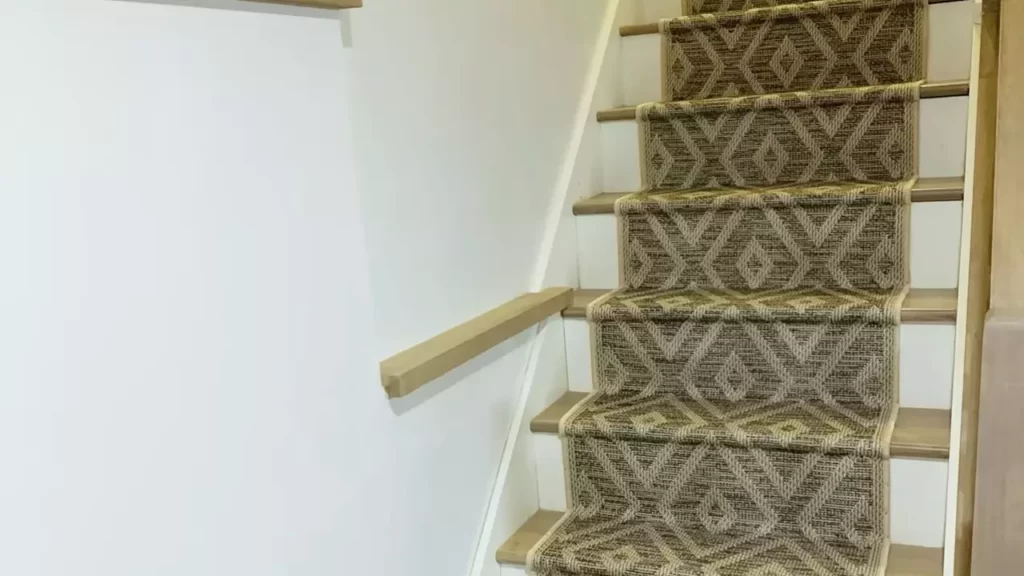
Cleaning And Maintaining The Carpet Runners
Regular vacuuming and spot cleaning
Regular vacuuming is crucial for keeping your carpet runners on the stairs looking fresh and clean. Dust, dirt, and debris can easily find their way onto your carpet runners, especially in high-traffic areas like the stairs. By vacuuming your carpet runners regularly, you can prevent dirt from settling in and causing damage to the fibers.
- Use a vacuum cleaner with a beater bar or rotating brush to thoroughly clean the carpet fibers.
- Pay extra attention to the edges and corners of the carpet runners where dust and debris tend to accumulate.
- Consider using a handheld vacuum or an attachment with a smaller brush head for hard-to-reach areas.
- For spot cleaning, start by blotting the stained area with a clean cloth or paper towel to absorb any liquid.
- Avoid rubbing the stain, as it can push the spill deeper into the carpet fibers or spread it to a larger area.
- Apply a carpet cleaning solution specifically designed for spot cleaning and follow the manufacturer’s instructions.
- Gently blot the stained area again with a clean cloth, working from the outside of the stain towards the center.
Dealing with spills and stains
Accidents happen, and spills and stains are inevitable. When dealing with spills or stains on your carpet runners, it’s important to act quickly to prevent the stain from setting and becoming more difficult to remove.
- Blot up any liquids as soon as possible using a clean cloth or paper towel.
- Be careful not to oversaturate the carpet with liquid, as excessive moisture can lead to mold or mildew growth.
- For solid or semi-solid spills like food or pet waste, gently scrape up the material with a spoon or blunt knife before blotting the area.
- Use a carpet stain remover or a mixture of mild detergent and water to treat the stain.
- Apply the solution to a clean cloth or sponge and blot the stained area, working from the outside of the stain towards the center.
- Rinse the area with clean water and blot again to remove any residue.
- Allow the carpet runners to dry completely before walking on them.
When to replace or repair the carpet runners
Over time, carpet runners on stairs can become worn, torn, or stained beyond repair. Knowing when it’s time to replace or repair your carpet runners is essential for maintaining the appearance and functionality of your stairs.
- If you notice excessive wear and tear, such as frayed edges or bald spots, it may be time to consider replacing the carpet runners.
- Deep-seated stains that cannot be effectively removed, even with professional cleaning, may also indicate the need for replacement.
- Loose or buckling carpet runners can be a trip hazard and should be repaired as soon as possible.
- If your carpet runners have developed a lingering odor despite regular cleaning, it may be a sign of mold or mildew growth underneath the carpet, necessitating replacement.
- Consider the overall age and condition of your carpet runners. If they are old and showing signs of significant wear, replacing them can improve the safety and aesthetic appeal of your stairs.
Remember, proper cleaning and maintenance of your carpet runners can extend their lifespan and keep them looking their best for years to come. So, make regular vacuuming, spot cleaning, and timely replacement or repair a part of your carpet runner care routine.
Frequently Asked Questions Of How To Install Carpet Runners On Stairs
Can You Install A Stair Runner Yourself?
Yes, you can install a stair runner yourself. It’s a DIY project that requires careful measurements, cutting the runner to size, and securing it with adhesive or staples. Make sure to follow instructions and use proper tools for a successful installation.
What Do You Use To Attach A Stair Runner?
Attach a stair runner using a combination of adhesive and nails.
How Do You Secure A Carpet Runner On Carpet?
To secure a carpet runner on the carpet, you can use double-sided carpet tape or adhesive strips. Place them along the edges and corners of the runner, pressing firmly to ensure a secure attachment. This prevents the runner from shifting or sliding, adding stability and safety to your carpeted area.
Do Stair Runners Need Underlay?
Yes, stair runners typically need underlay. Underlay adds cushioning, helps reduce noise, and improves the lifespan of the runner. It also provides additional safety by preventing the runner from slipping or moving. To ensure your staircase stays in optimal condition, it is advisable to use underlay with your stair runners.
Conclusion
To summarize, installing carpet runners on stairs is a great way to enhance the aesthetic appeal and safety of your home. By following the step-by-step guide provided in this blog post, you can ensure a successful installation process. Remember to measure accurately, choose the right materials, and secure the carpet runners firmly.
With proper installation, your stairs will not only look beautiful but also provide a cushioned and slip-resistant surface. So why wait? Upgrade your staircase today and enjoy the benefits of a stunning and functional home.
